Great Cumbrae is the larger of the two islands known as The Cumbraes in the lower Firth of Clyde in western Scotland. The island is sometimes called Millport, after its main town.
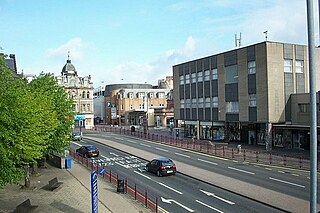
Hamilton is a large town in South Lanarkshire, Scotland. It serves as the main administrative centre of the South Lanarkshire council area. It sits 10 miles (16 km) south-east of Glasgow, 37 miles (60 km) south-west of Edinburgh and 74 miles (120 km) north of Carlisle. It is situated on the south bank of the River Clyde at its confluence with the Avon Water. Hamilton is the county town of the historic county of Lanarkshire and is the location of the headquarters of the modern local authority of South Lanarkshire.

Dunoon is the main town on the Cowal Peninsula in the south of Argyll and Bute, west of Scotland. It is located on the western shore of the upper Firth of Clyde, to the south of the Holy Loch and to the north of Innellan. As well as forming part of the council area of Argyll and Bute, Dunoon also has its own community council. Dunoon was a burgh until 1976.

Greenock is a town in Inverclyde, Scotland, located in the west central Lowlands of Scotland. The town is the administrative centre of Inverclyde Council. It is a former burgh within the historic county of Renfrewshire, and forms part of a contiguous urban area with Gourock to the west and Port Glasgow to the east.
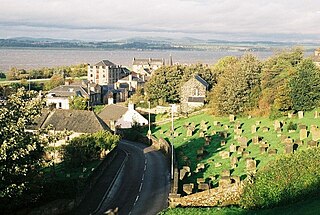
Borrowstounness, commonly known as Bo'ness, is a town and former burgh and seaport on the south bank of the Firth of Forth in the Central Lowlands of Scotland. Historically part of the county of West Lothian, it now lies within the Falkirk council area, 17 miles northwest of Edinburgh and 6+3⁄4 miles east of Falkirk. At the 2011 census, the population of Bo'ness was 15,100.

Dufftown is a burgh in Moray, Scotland. While the town is part of the historic Mortlach parish, the town was established and laid out in the early 19th century as part of a planned new town settlement. The town has several listed 19th century buildings and serves as a regional centre for agriculture, tourism and services. The town is well known for its whisky based economy, as it produces more whisky than any other town in Scotland and is home to several existing and former distilleries.
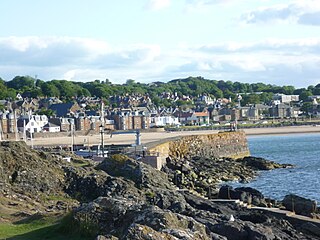
North Berwick is a seaside town and former royal burgh in East Lothian, Scotland. It is situated on the south shore of the Firth of Forth, approximately 20 miles (32 km) east-northeast of Edinburgh. North Berwick became a fashionable holiday resort in the nineteenth century because of its two sandy bays, the East Bay and the West Bay, and continues to attract holidaymakers. Golf courses at the ends of each bay are open to visitors.

Gourock is a town in the Inverclyde council area and formerly a burgh of the County of Renfrew in the west of Scotland. It was a seaside resort on the East shore of the upper Firth of Clyde. Its main function today is as a residential area, extending contiguously from Greenock, with a railway terminus and ferry services across the Clyde.
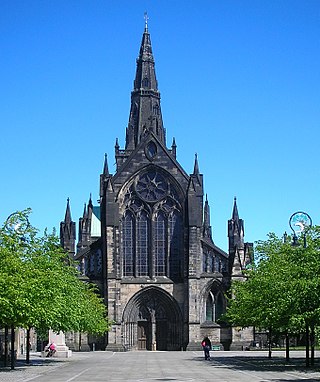
Glasgow Cathedral is a parish church of the Church of Scotland in Glasgow, Scotland. It is the oldest cathedral in mainland Scotland and the oldest building in Glasgow. The cathedral was the seat of the Archbishop of Glasgow, and the mother church of the Archdiocese of Glasgow and the province of Glasgow, until the Scottish Reformation in the 16th century. Glasgow Cathedral and St Magnus Cathedral in Orkney are the only medieval cathedrals in Scotland to have survived the Reformation virtually intact. The medieval Bishop's Castle stood to the west of the cathedral until 1789. Although notionally it lies within the Townhead area of the city, the Cathedral grounds and the neighboring Necropolis are considered to be their own district within the city.
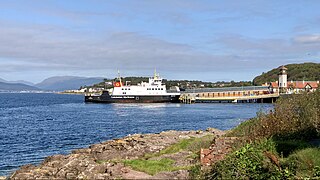
Wemyss Bay is a village on the coast of the Firth of Clyde in Inverclyde in the west central Lowlands of Scotland. It is in the traditional county of Renfrewshire. It is adjacent to Skelmorlie, North Ayrshire. The town and villages have always been in separate counties, divided by the Kelly Burn.
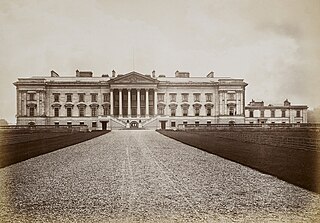
Hamilton Palace was a country house in Hamilton, South Lanarkshire, Scotland. It was the seat of the Dukes of Hamilton and is widely acknowledged as having been one of the grandest houses in the British Isles. The palace dated from the 14th century, was rebuilt in the Baroque style between 1684 and 1701 and was subsequently much enlarged in the Neoclassical style between 1824 and 1832.

James Gillespie Graham was a Scottish architect, prominent in the early 19th century.

The Glasgow Necropolis is a Victorian cemetery in Glasgow, Scotland. It is on a low but very prominent hill to the east of Glasgow Cathedral. Fifty thousand individuals have been buried here. Typical for the period, only a small percentage are named on monuments and not every grave has a stone. Approximately 3,500 monuments exist here.
John James StevensonFRSE FSA FRIBA, usually referred to as J. J. Stevenson, was a British architect of the late-Victorian era. Born in Glasgow, he worked in Glasgow, Edinburgh and London. He is particularly associated with the British Queen Anne revival style.
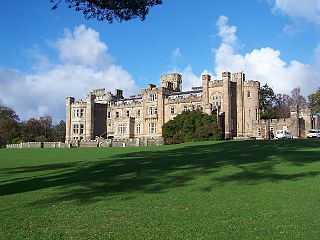
Castle Toward is a nineteenth-century country house on the Cowal Peninsula, in Argyll and Bute, west of Scotland.

Hunters Quay is a village, on the Cowal Peninsula, in Argyll and Bute, Scottish Highlands. Situated between Kirn to the south and Ardnadam to the north, Hunters Quay is the main base of Western Ferries, operating between Hunters Quay and McInroy's Point.
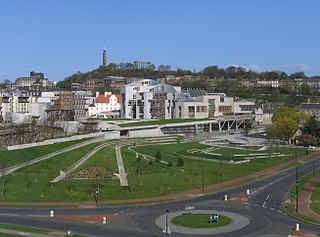
The architecture of Scotland includes all human building within the modern borders of Scotland, from the Neolithic era to the present day. The earliest surviving houses go back around 9500 years, and the first villages 6000 years: Skara Brae on the Mainland of Orkney being the earliest preserved example in Europe. Crannogs, roundhouses, each built on an artificial island, date from the Bronze Age and stone buildings called Atlantic roundhouses and larger earthwork hill forts from the Iron Age. The arrival of the Romans from about 71 AD led to the creation of forts like that at Trimontium, and a continuous fortification between the Firth of Forth and the Firth of Clyde known as the Antonine Wall, built in the second century AD. Beyond Roman influence, there is evidence of wheelhouses and underground souterrains. After the departure of the Romans there were a series of nucleated hill forts, often utilising major geographical features, as at Dunadd and Dunbarton.

John Henderson was a Scottish architect operational in the mid-19th century. He is chiefly remembered as a church architect, with his early work being in the Gothic revival and tractarian style, before developing his own distinct style.
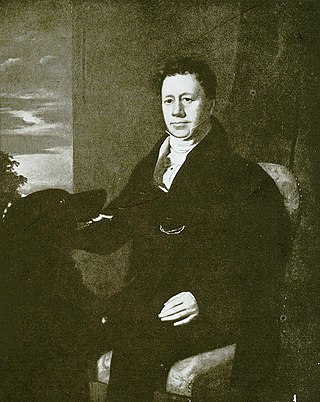
James Ewing of Strathleven MP FRSE LLD (1775–1853) was Lord Provost of Glasgow (1832–1833), and MP for Glasgow (1832–1835), a plantation owner, slave-holder and West Indies merchant.

McColl's Hotel was a hotel in Dunoon, Cowal, Argyll and Bute, Scotland. It stood, on Tom-a-Mhoid Road in the town's West Bay, adjacent to Castle Hill and the steamboat pier, between 1883 and 2015, when it was demolished. During its first century in operation, it was recognised as a desirable destination for tourists visiting the town, especially by steamboat. In 1910, it was listed in the World's Hotel Blue Book and Who's Who in the Hotel World, along with Dunoon's Argyll Hotel, Crown Hotel and Royal Hotel. While the Argyll was described as Dunoon's largest hotel, McColl's was noted as being its most select due to having its own grounds.




















